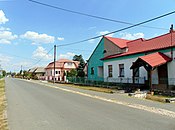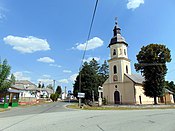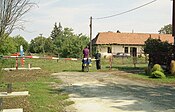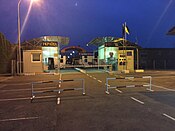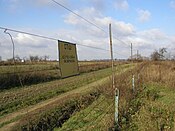Veľké Slemence
History
In historical records the village was first mentioned in 1332. It was a single village named Szelmenc (between 1919 and 1938 it was called Slemence) before 1945. From 1919 until 1945, Szelmenc bore the same history as Subcarpathian Rus'. It was first ceded to Czechoslovakia in 1919, then after the First Vienna Award in 1938 it returned to the Kingdom of Hungary, then back, then, after the Soviet-Czechoslovak Treaty in 1945 was partially ceded to the Soviet Union along with Subcarpathian Rus'. The new border between the two states ran through Szelmenc. The town was divided between Slovakia (2/3) and Ukraine (1/3) by cutting it into two parts - Veľké Slemence became a part of Slovakia and Mali Selmentsi (Малі Селменці) a part of Ukraine.
In 1946, a house which lay exactly on the border was demolished with all the other objects in the way, and a 6 meter high palisade wall with watch towers and border patrolling were installed. For the next 60 years crossing between the two parts was prohibited. To meet with relatives on the other side, locals had to first travel 13 km to Uzhhorod for visas to Czechoslovakia. If their visa application, which took at least two weeks, was successful, they would travel 80 km south to the nearest border crossing, then 80 km back, and return the same way. Previously 3–500 meters and a half day, the trip became at least 160–200 km long for one way only and took at least a month to organize. Those, who tried to shout over from one side to the other were penalized on both parts. This resulted in discussing, sending messages, news in form of songs, sung loud near the border.
"Egy Szelmencből lett a kettő, egyesítse a Teremető
Áldjon Isten békességgel, tartson egybe reménységgel
Mi reményünk megmarad, összeforr mi szétszakadt
Két Szelmencnek kapuszárnya, falvainkat egybezárja"
(the poem on the Mali Selmeci side of the Szekely gate)
In 2003, a Székely gate (székelykapu) was installed on the border, one half of it being in the Slovak, while the other half being on the Ukrainian part of the border, with a short poem on the Mali Selmentsi part. The poem can be roughly translated as "From one Szelmenc became two, should be unified by the Creator, God bless with peace and keep us together, our hope remains, and will join together what torn apart, gate wings of the two Szelmec closes our villages together".
After the fall of communism, and more than a decade of fights with bureaucracy and negligence, a border checkpoint for pedestrians and cyclists was established in 2005 on the street which was divided. It was opened on 23 December 2005, ending 61 years of division. On 1 January 2008, Slovakia joined the Schengen Agreement, resulting in tightening of the crossing between the two Szelmences once again. The residents of Mali Selmentsi were again forced to travel to Uzhhorod to apply at the Slovak Consular Office for a visa to enter Slovakia and the Schengen Area. On the other hand, as Slovak citizens, the residents of Veľké Slemence could enter Mali Selmentsi and Ukraine without a visa. However, on 11 June 2017, the visa policy of the Schengen Area was amended. Ukrainian citizens holding biometric passports no longer require a visa to enter the Schengen Area for up to 90 days in a 180-day period. At present, the border between the two Szelmences can only be crossed by pedestrians and cyclists who are EU, EEA, Swiss and Ukrainian citizens.
The two parts have a total population of about 840 people, almost exclusively (+95%) ethnic Hungarians, with a few Romani in and around the village(s).
The elderly citizens of the two Szelmences were once citizens of Austria-Hungary, Czechoslovakia, the Kingdom of Hungary, and the Soviet Union, and now are the citizens of Slovakia (and thus the European Union) and Ukraine, while most of them have never left the village, where they were born.
The divided town, its inhabitants, and their relationships across the border, particularly in the context of the Russian invasion of Ukraine, became the subject of the 2023 book Hranica: príbehy zo slovensko-ukrajinského pohraničia by Slovak journalist Stanislava Harkotová.
Geography
This section needs expansion. You can help by adding to it. (July 2022) |
The village lies at an altitude of 106 metres and covers an area of 9.972 km. The municipality has a population of about 600 inhabitants.
Culture
This section needs expansion. You can help by adding to it. (July 2022) |
The village has a football pitch.
Education
This section needs expansion. You can help by adding to it. (February 2023) |
Bibliography
- Zelei, Miklós: A kettézárt falu. Ister Kiadó, Budapest, 2000.
Gallery
-
Main street in Veľké Slemence
-
Greek Catholic church in Veľké Slemence (July 2014)
-
Pedestrian border crossing between Slovakia and Ukraine in Veľké Slemence, freshly opened in the late 2000s
-
The pedestrian border crossing between Slovakia and Ukraine in Veľké Slemence (Slovak side of the border, August 2018)
-
The pedestrian border crossing between Veľké Slemence, Slovakia and Mali Selmentsi, Ukraine as seen from Ukrainian side of the border, June 2017, night time.
-
Barbed wire at guarded border between Slovakia and Ukraine in Veľké Slemence
References
- ^ "Hustota obyvateľstva - obce [om7014rr_ukaz: Rozloha (Štvorcový meter)]". www.statistics.sk (in Slovak). Statistical Office of the Slovak Republic. 2022-03-31. Retrieved 2022-03-31.
- ^ "Základná charakteristika". www.statistics.sk (in Slovak). Statistical Office of the Slovak Republic. 2015-04-17. Retrieved 2022-03-31.
- ^ "Počet obyvateľov podľa pohlavia - obce (ročne)". www.statistics.sk (in Slovak). Statistical Office of the Slovak Republic. 2022-03-31. Retrieved 2022-03-31.
- ^ Lyman, Rick (10 August 2015). "A Ukrainian Border Town Once Fenced by Soviets Blossoms Into a Shopper's Paradise". The New York Times.
- ^ Chapman, Carolyn (July 2004). "Slovak Ambassador Lobbies for Divided Village". The Washington Diplomat. Archived from the original on 3 October 2011.
- ^ Uhríková, Dominika (11 February 2008). "Leaving the east behind". The Slovak Spectator.
- ^ "The state border crossing". Ministry of the Interior (Slovakia). 2021-02-12. Archived from the original on 2022-04-17.
- ^ Harkotová, Stanislava (2023). Hranica: príbehy zo slovensko-ukrajinského pohraničia (in Slovak) (1st ed.). Bratislava: Ringier Slovakia Media. ISBN 9788097448813.
- Egy határátkelés tapasztalatai, Találjuk ki Közép-Euópát?, September 19, 2007 (Hungarian)
- Schengenjárás Szelmencen, September 7, 2007 (Hungarian)
- Pic of the old border on Flickr
- A videoreport in English, made by the American Hungarian Federation, americanhungarianfederation.org, 2004 (English)
- News From Szelmenc, americanhungarianfederation.org (English only)
- Vasfüggöny után újabb vasfüggöny, Új Szó online, November 7, 2003 (Hungarian)
